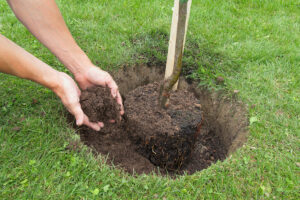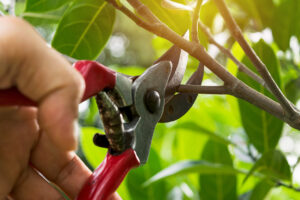When you hear the term “orchard,” you might think of acre upon acre of trees laden with fresh, ripe apples or peaches.
But you don’t need a vast expanse of land to grow your own fruit. When you visit our Somerset, NJ garden center, you’ll find heirloom fruits and berries designed for home growing. They come to us courtesy of our suppliers at Hollybrook Orchards, a longtime proponent of home orcharding.

All of Hollybrook’s fruit trees are container grown for several years before being handed over to our customers, ensuring they’ll get trees with a well-developed root system. The better the root system, the better the fruit.
“Bareroot trees are dug in the fall, cleaned of the dirt around the roots and stored in a cooler during the winter,” Hollybrook says on its website.
“They require extra care when they are planted. This is because their root systems have been disturbed when they were dug. As much as half of their roots are destroyed in the digging process. They will grow back, but you need to coddle the tree to coax them back. The tree will grow much less in the first year, because all of its energy will go to restore the root system.”
The same holds true for fruits sold in plastic bags or a pot filled with sawdust or loose soil. To have a successful home orchard, you’ll need mature, container grown trees with a strong root system.
Beyond container-grown trees, Hollybrook offers these tips for beginning your own home orchard:
1. Pollination

Fruit grows from pollinated blossoms. Some trees are self-pollinating, meaning they can produce healthy fruit crops with their own pollen.
But other trees need other varieties of pollination, what’s known as cross-pollination. This is usually done by bees. Some neighborhoods have enough fruit trees to guarantee regular cross-pollination, but you should still plant some “pollination partners” to be safe.
If a tree isn’t a self-pollinator, another tree of the same variety will not provide cross-pollination. Trees that need a pollinator include apples, pears, plus and sweet cherries. Peaches, apricots, nectarines and tart cherries will almost always self-pollinate.
Our Somerset NJ garden center can advise you on the right pollinators for your trees. And remember that pollinators have to be from the same fruit: a pear can’t pollinate an apple tree.
2. Location

Consider these factors when picking a spot for your home orchard:
- Sunshine – Place your tree in as pot that gets at least a half-day of sun. never plant your tree in any area that’s fully shaded.
- Soil – Fruit trees need well-drained, fertile soil.
- Spacing – Plant container-grown trees 12 to 14 feet away from each other. If you plant more than one row, make sure the rows 18 to 20 feet apart.
In addition, you should also think in the long term when setting up an orchard. You might decide to plant new varieties down the road, so allow for room for additional trees.
3. Planting and watering
After removing the tree from its plastic container, be sure to dispose of it responsibly. Separate the roots at the bottom, allowing them to spread. Pruning tightly packed roots in three or four places can promote new growth.
Dig a hole deep enough to hold the root system but shallow enough that the “bud union” (the bugle at the base of the tree) is an inch and a half to two inches above the surface for all dwarf and semi-dwarf trees. Planting the bud union below ground will result in the tree becoming full-sized.
Fill in half the hole with soil, then fill it to the top with water. When the water has soaked into the earth, fill the rest of the hole.
Water the tree once per week during the first season if it hasn’t rained. Don’t let the tree dry out. The first year is important for root growth and expansion. After the first year, you won’t need to water the tree except during droughts.
4. Fertilizing
NEVER put manure or fertilizer in the hole when you plant the tree, as this will hurt the root system. Wait until the tree has been in the ground a few weeks, then apply ¼ cup of 10-10-10 fertilizer in a two foot circle around the tree.
5. Spraying
Insects love fruit the same way you do. Talk to your Somerset, NJ garden center about the best home orchard spray to keep bugs and fungi away from your fruit. Follow the directions to keep your trees healthy and prolific.
6. Pruning

“We cannot stress enough the importance of regular, annual, aggressive pruning,” Hollybrook writes. “It is essential to maintain the ongoing vigor of the tree and to maximize the production of fruit.”
And different fruits need pruning at different times:
- Apples and pears – Prune these trees when they are dormant. Wait for a sunny day during winter. But if your tree is growing too aggressively, prune it in summer to control growth.
- Cherries – These trees are best pruned in hot weather. Pruning in cold weather can expose the trees to bacterial disease.
- Peaches, apricots and nectarines – Prune these trees in early spring, but after your region’s last frost date to minimize late frost damage.
- Plums – These are vigorous trees that need aggressive pruning. You can do a clean-up pruning in winter, then again in July to keep the tree manageable.
If you have any questions about home orcharding, or if you’re ready to start planting some fruit trees of your own, Mendham Garden Center can help.
The experts at Mendham Garden Centers in Mendham, Chester, & Annandale can advise you on the best ways to keep your trees healthy, while also providing you with top-quality trees from our friends at Hollybrook. Stop in today to learn more.

